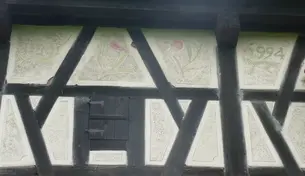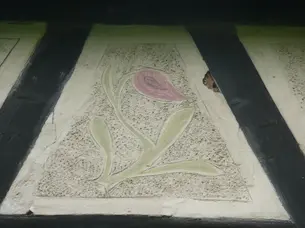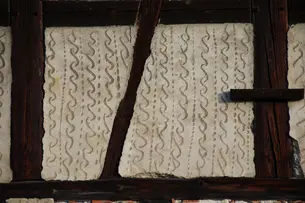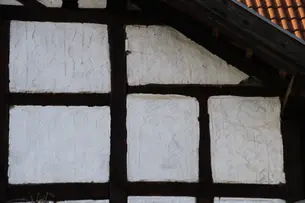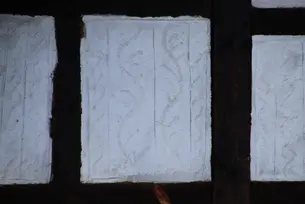Scraper plaster in Upper Franconia
Content and aims
Ornamented plaster is the generic term for an architectural tradition that was cultivated by painters and plasterers, especially in rural areas, and for which the term "scratch plaster" is generally used. Common to all these plasters is a design of the surface by scraping, scratching, stippling, smoothing. Both the relief and the contrast of smooth to rough surfaces characterize the appearance. The individual compartments remain natural or are subsequently whitewashed over the entire surface. Colored accentuation of ornaments, on the other hand, occurs only sporadically.
Problem
The ornamented plastering of the compartments was once a widespread handicraft technique. Evidence is found in Hesse, Thuringia, Lower Franconia, Upper Franconia, Middle Franconia, Baden-Württemberg and Hamburg. In Bavaria, the verifiable population extends over the three Franconian administrative districts. The occurrence is however so far not area-covering proven, but island-like. Between regions with a rich occurrence lie other regions, for which so far only Gefacheputze without design became known. In the region of Upper Franconia, the geographical distribution is still unclear.
The economic revival of the old Federal Republic also involved a structural change in the traditional building trade. Old techniques disappeared and made way for modern construction and renovation techniques. As a result, it must be stated that the radical repair methods of the 20th and 21st centuries destroyed large areas of historic substance. As a result of this development, the number of buildings with ornamented compartment plasters is also declining.
One reason for this is that buildings designed with scratch plaster are usually not protected. Therefore, their long-term preservation cannot be taken for granted.
Project
In the years 2008 to 2009, scratch plaster was scientifically recorded and documented for the first time in a comprehensive and area-wide manner. A first campaign was carried out by the Franconian open-air museums in Fladungen and Bad Windsheim. At that time, the plaster inventories in Lower Franconian villages in the districts of Haßberge and Rhön-Grabfeld were recorded.
At the present time, the Lower Franconian as well as the Southern Thuringian area has already been surveyed to the greatest possible extent. On the Upper Franconian side, however, there is so far hardly any knowledge about the distribution of the historical craft technology. Therefore, the preserved stock in Upper Franconia will be documented in a new campaign in 2019 to 2020.
The project was made possible by funding from the Oberfranken Stiftung.
Methodology and objectives
The investigations not only address the aesthetic design, but also dealt with their materiality and method of manufacture.
On the one hand, the material properties of the plasters essentially determine their appearance, the color of the sand, its grain size as well as the properties of the binder are to be mentioned here, on the other hand, the material properties determine the state of preservation of the plaster fields. The fact that in some study areas (e.g. Haßberge, Thuringia) historically ornamented fields have been preserved on such a large scale over a long period of time is certainly also due to the dolomitic portion of the binder there, while the clayey lime plasters along the Regnitz in Upper Franconia have largely decayed. Only on the basis of exact knowledge of the material can sustainable maintenance and repair concepts as well as suitable repair mortars be developed.
Clarification of the manufacturing techniques is also indispensable for the practical preservation of monuments, because in many cases, in addition to purely conservational protection of the inventory, it will also be a matter of selective supplementation of at least individual defective areas.

